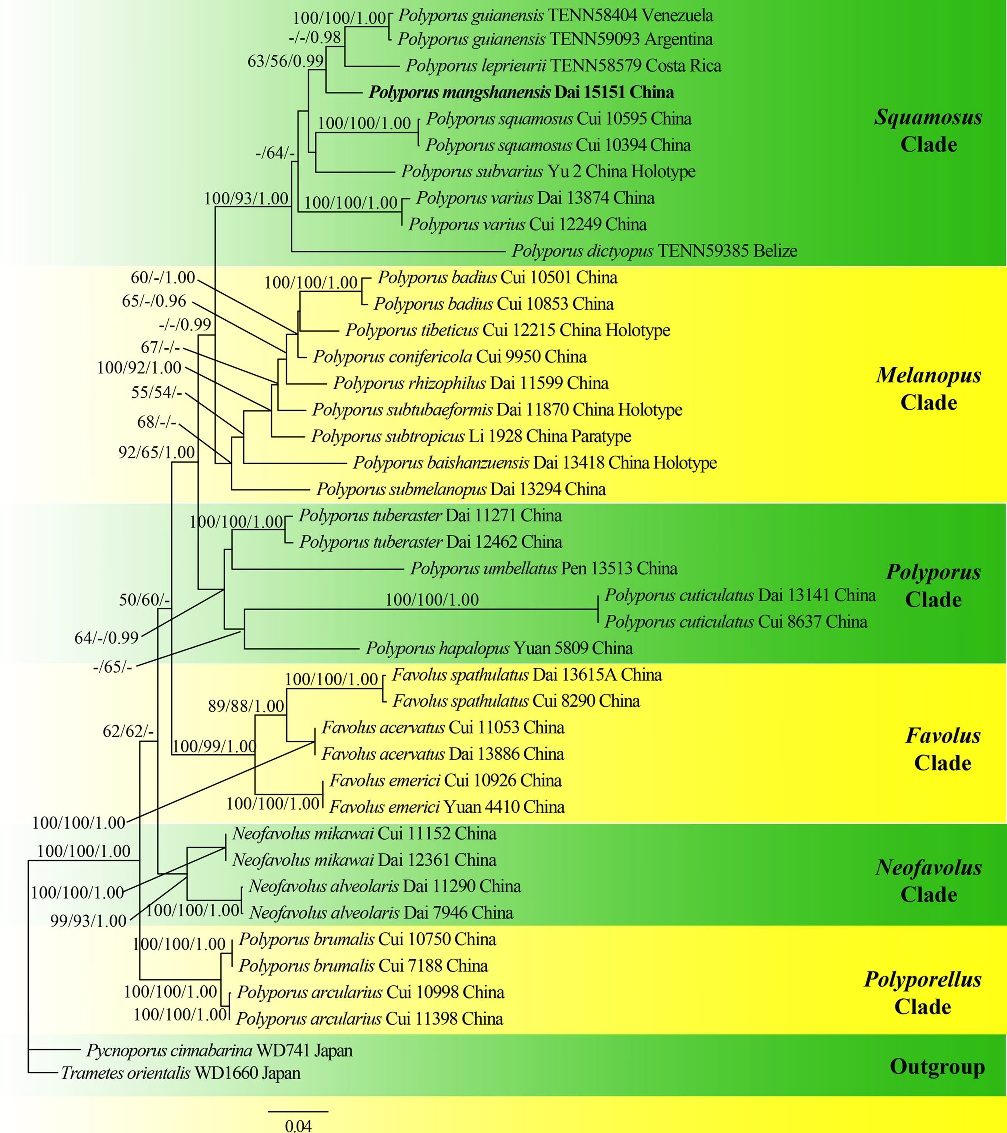Polyporus mangshanensis B.K. Cui, J.L. Zhou & Y.C. Dai
Index Fungorum number: IF552159 Facesoffungi number: FoF02471
Etymology: mangshanensis, referring to the locality of the type specimen.
Holotype: BJFC 018267.
Basidiocarps annual, eccentrically to almost laterally stipitate, solitary, corky when dry; pileus reniform, projecting
up to 5.8 cm long, 10.5 cm wide and 2.5 cm thick; pileal surface beige, saffron yellow to yellowish-orange when dry, azonate, with slightly radial stripes, smooth and glabrous; margin sharp and involute upon drying; pore surface brown beige to olive brown when dry; pores angular, 3–5 per mm, occasionally elongated to 1 mm long and 0.5 mm wide; dissepiments thin, entire to lacerate; context buff when dry, up to 1.2 mm thick; tubes concolorous with the pore surface, slightly decurrent on the stipe, up to 1.5 mm long; stipe cylindrical, context of stipe buff when dry, bearing dark brown cuticle, becoming tan towards the tuber layer, glabrous, curvy and wrinkled upon drying, up to 2 cm long and 7 mm diam. Hyphal system dimitic; generative hyphae bearing both clamp connections and simple septa; skeleto-binding hyphae IKI–, CB–; tissues unchanged in KOH. Contextual generative hyphae frequent, colourless, thin-walled, bearing clamp connections, frequently branched, 2.5–8 um diam., usually inflating at the branching areas or clamping areas, up to 14 um in diam.; contextual skeleto-binding hyphae dominant, colourless, thick-walled with a narrow to wide lumen, frequently branched, flexuous, interwoven, 2.5–6.5 um diam., occasionally inflated up to 11 um diam.; contextual cuticle hyphae simple septate, thin-walled, frequently branched, interwoven, 1.5–4.5 um diam. Tramal generative hyphae frequent, colourless, thin-walled, bearing clamp connections and simple septa, infrequently branched, 2.5–4 um diam.; tramal skeleto-binding hyphae dominant, colourless, thick-walled with a narrow to wide lumen, frequently branched, flexuous, interwoven, 1.3–4 um diam. Stipe generative hyphae frequent, colourless, thin-walled, bearing clamp connections, occasionally branched, 1.5–6 um diam.; stipe skeleto binding hyphae dominant, colourless, thick-walled, subsolid or with a narrow to wide lumen, moderately branched, flexuous, interwoven, 2.5–6 um diam.; stipe cuticle generative hyphae dominant, with buff inclusion inside, thick-walled with a wide lumen, bearing clamp connections; stipe cuticle skeleto- binding hyphae frequent, with light brown to orange brown inclusion inside, thick-walled with a narrow lumen, occasionally branched, 2.4–4.5 um diam. Cystidia and cystidioles absent; basidia clavate, with a basal clamp and four sterigmata, 16.5–24 × 7–10 um; basidioles in shape similar to basidia, but smaller and without sterigmata. Basidiospores cylindrical, few, oblong, colourless, thin-walled, smooth, with guttules, IKI–, CB–, (6.5–)7.5–10.5(–11) × 3.5–4.5 (–5) um, L = 8.7 um, W = 4.07 um, Q = 1.84–2.53, Qm = 2.14 (n = 60/1).
Type of rot: White rot.
Specimens examined: CHINA, Hunan Province, Yizhang County, Mangshan Nature Reserve, on fallen angiosperm branch, 17 August 2014, Dai 15151 (BJFC 018267, holotype).
Notes: Recently, taxonomic and phylogenetic studies of wood-rotting fungi in subtropical China have been carried out, and many new species have been described based on both morphological characters and molecular data (Chen
and Cui 2014, 2016; Chen et al. 2015c, 2016; Han et al. 2016; Li and Cui 2013; Li et al. 2014; Song et al. 2014, 2016; Zhao et al. 2013, 2015a). In the current study, Polyporus mangshanensis is an additional new species described from subtropical China on the basis of morphological characters and phylogenetic analysis. Morphologically, P. mangshanensis is characterized by its beige to yellowish-orange pileal surface with slightly radial stripes, brown beige to olive brown pore surface, dark brown stipe, generative hyphae bearing both clamp connections and simple septa, and oblong to cylindrical basidiospores (7.5–10.5 × 3.5–4.5 um). Phylogenetically, P. mangshanensis clustered with P. leprieurii Mont. and P. guianensis Mont.; morphologically, they produce similar pileal surface, pore surface and dark stipe, however, P. mangshanensis differs from the latter two species by producing both clamped and simple-septate generative hyphae, contextual generative hyphae and skeleto- binding hyphae usually inflated over 10 um in diam. Moreover, pores and basidiospores of P. mangshanensis are smaller than P. guianensis (pores 1–2 per mm, basidiospores 8–12 × 2.5–4 um), while larger than P. leprieurii (pores 5–8 per mm, basidiospores 4.5–7 × 2–2.5 um; Nu´n˜ez and Ryvarden 1995). Polyporus subvarius C.J. Yu & Y.C. Dai has a similar pileal and pore surface to P. mangshanensis, but the former has larger pores (1–2 per mm) and basidiospores (9.2–12.6 × 3.9–4.9 um, L = 10.7 um, W = 4.48 um), only clamped generative hyphae, and grows on living trees of Salix (Dai et al. 2007). Polyporus admirabilis Peck resembles P. mangshanensis in having a laterally dark stipe, a tan pileal surface and similar pore size, but it differs in its subulate cystidioles, only clamped generative hyphae, and slender basidiospores (7.8–9 × 3–3.5 um, L = 8.29 um, W = 3.12 um, Qm = 2.66; Dai 1999). Both Polyporus badius (Pers.)A.B.De and P. submelanopus H.J. Xue & L.W. Zhou have simple-septate generative hyphae, dark stipe and cylindrical basidiospores, which are similar to P. mangshanensis. Polyporus badius has darker pileal surface and smaller pores (5–6 permm), only simple-septate generative hyphae (Dai 1999); while P. submelanopus has larger pores (2–3 per mm) and basidia (24–33 × 5–8 um), and a terrestrial habit (Xue and Zhou 2012).

Polyporus mangshanensis (holotype). a Basidiospores. b Basidia and basidioles. c Hyphae from context. c1 Generative hyphae, c2 Skeleto-binding hyphae. d Hyphae from cuticle. d1 Contextual cuticle hyphae. d2 Stipe cuticle hyphae. e Hyphae from stipe. e1 Generative hyphae. e2 Skeleto-binding hyphae. f Hyphae from trama. f1 Generative hyphae. f2 Skeleto-binding hyphae. Scale bars a–f = 10 um

Phylogeny of Polyporus and related genera generated by maximum likelihood based on combined ITS x LSU sequence data. Branches are labeled with maximum likelihood bootstrap proportions (the former values) higher than 50 %, maximum parsimony bootstrap proportions (the middle values) higher than 50 % and Bayesian posterior probabilities (the latter values) more than 0.95

